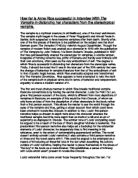A common sentiment between all youths is alienation; both authors relate to their readership, via fantasy worlds, possibilities outside of their respective realities. The initial characters in 'Harry Potter' epitomise the 'perfect family,' a nonexistent, forced, social ideal many young people are pressured to believe and desire. Rowling represents this cliché subversively, these 'perfectly normal' characters are 'boring' and abrasive, they 'yell' and 'gossip' dismissing anything 'mysterious,' representing the adventure and excitement of which children dream, as 'nonsense,' a reaction the growing pre-teenage audience will recognise. These characters embody the repressive world Rowling's audience wish to escape. With 'Lestat' Rice introduces a world already accepting supernatural ideas; the intended audience view themselves as analogous to the tradition portrayal of the vampire, shunned and reviled: they are the 'perfect horror('s)' Lestat explains he used to be, but in the reality Rice creates Lestat claims he will not 'let that happen now,' in Lestat's universe the once derided, loathed vampires are free and even worshipped. Rice welcomes her nonconforming readers to enjoy Lestat's success: his '4 million' fans and his 'Rock Star' status. This contrasts 'Harry Potter's' opening: the 'Lestat' readership enjoy an amiable beginning, led by a confident although egotistic narrator while 'Harry Potter' fans experience the alienation later received by the protagonist, strengthening their identification with him, something that may not be obtained in 'Lestat.'
Due to the differing audience, each author employs variants of popular culture most relevant to their respective target age groups. With 'Harry Potter' this means the readers are able to escape from the 'boring ties' of their oppressive teachers and school uniforms into a 'secret,' 'mysterious,' obfuscated land of 'emerald-green cloaks' beyond subjugation, outside the jurisdiction of their ruling tyrannical elders, beyond their mundane life and into a domain adults choose to ignore 'thank you very much.' Conversely, Rice strives to beguile her audience with references to Lestat's age, a large 'two hundred' years, during which a large, compelling history could be compiled allowing for a wide breadth of story and detail, and his appearance upon popular teenage oriented music station 'MTV.' These issue a myriad of surrogate experiences, although this could be intimidating to her, likely lacking in confidence, audience. Attempting to palliate this Rice endows Lestat with weakness in his 'glass' fingernails, demonstrating a fragility behind his haughty exterior. This humanisation is amplified further when Lestat's 'transparent' skin is described, he espouses the need for it to be hidden beneath make-up, which further characterises him as narcissistic but could also be Rice's own metaphorical acknowledgement of the 'transparent' nature of the character she has created and impels the reader to continue onward with promises of a multifaceted, imperfect character with whom the reader can familiarise and to whom they can bond. In 'Harry Potter,' Rowling too makes pellucid promises, here of a quintessential magical journey of a blithesome bildungsroman and literate, map reading cats, naturally appealing to any child (or adult) lacking in literary aptitude.
The introductions to both of these texts utilise their fantasy genre in opposite ways. 'Lestat' venturing to provide extreme escapism for a confused, teenage demographic desiring an authoritative, illuminating guide who has already overcome the hostilities with which they currently contend and must learn to conquer. While 'Harry Potter' attempts to mirror common childhood experiences, allowing edification of courage and understanding in and of personal adversity.
(Word-count: 790)








